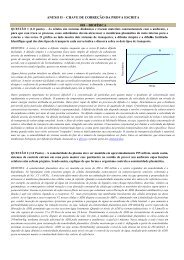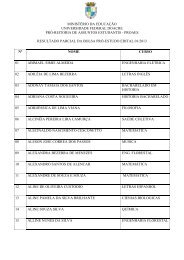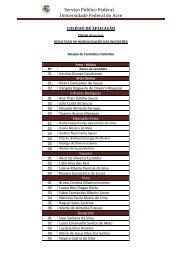450Records of the Crowned Eagle (Urubitinga coronata) in Moxos plains of Bolivia and observations about breeding behaviorIgor Berkunsky, Gonzalo Daniele, Fe<strong>de</strong>rico P. Kacoliris, Sarah I. K. Faegre, Facun<strong>do</strong> A. Gan<strong>do</strong>y, Lyliam González & José A. Díaz Luque1 December 2007) and two six-ban<strong>de</strong>d armadillos(Euphractus sexcinctus one individual on 23 November2007 and another individual on 7 January 2008). Reportedprey of Crowned Eagles in other countries inclu<strong>de</strong>terrestrial vertebrates such as armadillos (Dasypodidae),skunks (Mustelidae), opposums (Di<strong>de</strong>lphidae), tinamous(Tinamidae), <strong>do</strong>mestic chickens (Gallus <strong>do</strong>mesticus),some reptiles, <strong>de</strong>ad animals and fishes (Collar et al.1992, Bellocq et al. 2002, Maceda et al. 2003, Maceda2007, Tittarelli & Villarreal 2009, Pereyra Lobos et al.2011). As in other countries, armadillos seem to havean important role in the eagle’s diet during the breedingseason (Maceda et al. 2003, Pereyra Lobos et al. 2011).Armadillos and other terrestrial animals are usuallyaffected by fire, an annual human activity in Moxos plains(Langstroth Plotkin 1996). These fires could be affectingthe availability of prey for Crowned Eagles.New localities reported in this work suggest thatMoxos plains are a favorable environment for the speciesand its presence could be better known. The plains ofMoxos is an important site for the species. We observed atleast seven individuals, including family groups, juvenilesand a nestling, confirming the reproduction of CrownedEagles in Moxos plains. Botflies and fire may act aspotential threats for this northwestern-most populationof the endangered Crowned Eagle.ACKNOWLEDGMENTSMost of these observations were possible thanks tothe Blue-throated Macaw Conservation Project (WorldParrot Trust). We thank Wilfre<strong>do</strong> Villavicencio, RobertoFernan<strong>de</strong>z (Don Bobby), Hernán Parada and Fernan<strong>do</strong>Ávila for allowing us to work on their properties. SergioSeipke provi<strong>de</strong>s valuable suggestions to improve themanuscript.REFERENCESAraujo, N.; Ibisch, P. & Cuellar, S. 2001. Diagnóstico <strong>de</strong> Biodiversida<strong>de</strong> insumos técnicos para el Plan <strong>de</strong> Manejo <strong>de</strong>l área ProtegidaMunicipal Santiago, Tucavaca. Santa Cruz <strong>de</strong> la Sierra: FundaciónAmigos <strong>de</strong> la Naturaleza, Informe Técnico.Bal<strong>de</strong>rrama, J. A.; Olivo, C.; Flores, B. & Crespo, M. 2009.Harpyhaliaetus coronatus, p. 337-338. In: Ministerio <strong>de</strong> MedioAmbiente y Agua (eds). Libro rojo <strong>de</strong> la fauna silvestre <strong>de</strong>vertebra<strong>do</strong>s <strong>de</strong> Bolivia. La Paz: Ministerio <strong>de</strong> Medio Ambientey Agua.Barcellos, A. & Accordi, I. A. 2006. New records of the CrownedEagle, Harpyhaliaetus coronatus, in the State of Rio Gran<strong>de</strong> <strong>do</strong> Sul,southern Brazil. <strong>Revista</strong> <strong>Brasileira</strong> <strong>Ornitologia</strong>, 14: 345-349.Bellocq, M. I.; Bonaventura, S. M.; Marcelino, F. N. & Sabatini,M. 1998. Habitat use of Crowned Eagles (Harpyhaliaetuscoronatus) in the southern limits of the species’ range. Journal ofRaptor Research, 32: 312-314.Bellocq, M. I.; Ramírez-Llorens, P. & Filloy, J. 2002. Recent recordsof Crowned Eagles (Harpyhaliaetus coronatus) from Argentina.1981-2000. Journal of Raptor Research, 36: 206-212.Birdlife International. 2012. Species factsheet: Harpyhaliaetuscoronatus. http://www.birdlife.org (access on 24 January 2012).Brace, R. C.; Hornbuckle, J. & Pearce-Higgins, J. W. 1997. Theavifauna of the Beni Biological Station, Bolivia. Bird ConservationInternational , 7: 117-159.Collar, N. J.; Gonzaga, L. P.; Krabbe, N.; Madroño Nieto, A.;Naranjo, L. G.; Parker III, T. A. & Wege, D. C. 1992. Threatenedbirds of the Americas: the ICBP/IUCN Red Data Book. Cambridge:International Council for Bird Preservation.Denevan, W. 1980. La geografía cultural <strong>de</strong> los aborígenes <strong>de</strong> los Llanos<strong>de</strong> Mojos. La Paz: Sibiria Ed. Juventud.Ferguson-Lees, J. & Christie, D. A. 2001. Raptors of the World. NewYork: Houghton and Mifflin Company.Hennessey, A. B.; Herzog, S. K. & Sagot, F. 2003. Lista anotada <strong>de</strong>las aves <strong>de</strong> Bolivia. Santa Cruz <strong>de</strong> la Sierra: Asociación Armonía/BirdLife International.IUCN. 2012. IUCN Red List of Threatened Species. Version 2012.1.www.iucnredlist.org. (access on 27 August 2012)Kingsbury, J. & McNeill, D. 2010. Bolivia 2010, A joint GlasgowUniversity and Bolivian conservation expedition to the Beni savannahof Bolivia. Glasgow: Glasgow University.Kratter, A. W.; Scotts Illett, J. T.; Terry Chesser, R.; O’Neill, J. P.;Parker, T. A. & Castillo, A. 1993. Avifauna of a Chaco locality inBolivia. Wilson Bulletin, 105: 114-141.Langstroth Plotkin, R. 1996. Forest islands in an amazonian savannaof northeastern Bolivia. Ph.D. dissertation. Madison: University ofWisconsin-Madison.Maceda, J. J. 2007. Biología y conservación <strong>de</strong>l Águila coronada(Harpyhaliaetus coronatus) en Argentina. Hornero, 22: 159-171.Maceda, J. J.; Sarasola, J. H. & María Pessino, M. E. 2003. Preyconsumed by the Crowned Eagle (Harpyhaliaetus coronatus) in thesouthern limits of its range in Argentina. <strong>Ornitologia</strong> Neotropical,14: 419-422.Maillard, O.; Quillén Vi<strong>do</strong>z, J. & Herrera, M. 2008. Registrossignificativos <strong>de</strong> aves para el <strong>de</strong>partamento <strong>de</strong>l Beni, Bolivia: parte2. Kempffiana, 4: 8-12.Monteiro Granzinolli, M. A.; Garcia Pereira, R. J. & Motta-Junior,J. C. 2006. The Crowned Solitary-Eagle Harpyhaliaetus coronatus(Accipitridae) in the cerra<strong>do</strong> of Estação Ecológica <strong>de</strong> Itirapina,southeast Brazil. <strong>Revista</strong> <strong>Brasileira</strong> <strong>Ornitologia</strong>, 14: 429-432.Pereyra Lobos, R.; Santan<strong>de</strong>r, F. J.; Alvara<strong>do</strong> Orellana, S.; Ramírez,P. A.; Muñoz, L. & Fernán<strong>de</strong>z Bellón, D. 2011. Diet of theCrowned Eagle (Harpyhaliaetus coronatus) during the breedingseason in the Monte Desert, Men<strong>do</strong>za, Argentina. Journal ofRaptor Research, 45: 180-183.Quiroga, O. A. & Malo, A. F. 2006. Composición <strong>de</strong> la avifauna <strong>de</strong>lárea protegida Pantanal <strong>de</strong> Otuquis (Santa Cruz, Bolivia). <strong>Revista</strong>Boliviana <strong>de</strong> Ecología y Conservación Ambiental, 19: 59-73.Rocha, O. 1990. Lista preliminar <strong>de</strong> aves <strong>de</strong> la Reserva <strong>de</strong> la Biosfera“Estación Biológica Beni”. Ecología en Bolivia, 15: 57-68.Sarasola, J. H. & Maceda, J. J. 2006. Past and current evi<strong>de</strong>nceof persecution of the Endangered crowned eagle Harpyhaliaetuscoronatus in Argentina. Oryx, 40: 347-350.Thiollay, J. M. 1994. Family Accipitridae, p. 52-205. In: J. <strong>de</strong>l Hoyo,J. Elliot. & J. Sargatal (eds.). Handbook of the birds of the world,New World vultures to guineafowl, v. 2. Barcelona: Lynx Edicions.Tittarelli, R. F. & Villarreal, D. 2009. Alimentación piscívora <strong>de</strong>un pichón <strong>de</strong> águila coronada (Harpyhaliaetus coronatus) en losbaña<strong>do</strong>s <strong>de</strong>l Atuel, La Pampa, Argentina. Nuestras Aves, 54: 41-42.Vi<strong>do</strong>z, J. Q.; Jahn, A. E. & Mamani, A. M. 2010a. The avifauna ofEstación Biológica Caparú, Bolivia. Cotinga, 32: 51-68.Vi<strong>do</strong>z, J. Q.; Aponte, M. A.; Velásquez, M. A. & Alarcón, R.2010b. Contribución al conocimiento <strong>de</strong> la avifauna <strong>de</strong>l ParqueNacional Kaa-Iya <strong>de</strong>l Gran Chaco, <strong>de</strong>partamento <strong>de</strong> Santa Cruz,Bolivia. <strong>Revista</strong> <strong>Brasileira</strong> <strong>Ornitologia</strong>, 18: 34-44.<strong>Revista</strong> <strong>Brasileira</strong> <strong>de</strong> <strong>Ornitologia</strong>, 20(4), 2012
<strong>Revista</strong> <strong>Brasileira</strong> <strong>de</strong> <strong>Ornitologia</strong>, 20(4), 451-452Dezembro <strong>de</strong> 2012 / December 2012NOTA/SHORT-COMMUNICATIONPredation of Long–tailed Silky Flycatcher (Ptilogonyscaudatus) by Ornate Hawk–Eagle (Spizaetus ornatus)in a cloud forest of Costa RicaVíctor Acosta-Chaves 1,2,3,4 , Fe<strong>de</strong>rico Grana<strong>do</strong>s-Rodríguez 2 and David Araya-Huertas 2,31Sistema <strong>de</strong> Estudios <strong>de</strong> Posgra<strong>do</strong> en Biología, Universidad <strong>de</strong> Costa Rica, San Pedro, Costa Rica.2Escuela <strong>de</strong> Ciencias Biológicas, Universidad Nacional, Heredia, Costa Rica3Fundación Rapaces <strong>de</strong> Costa Rica. PO Box 1626-3000 Heredia, Costa Rica.4Corresponding author: vacosta@rapaces<strong>de</strong>costarica.comReceived on16 February 2012. Accepted on 24 August 2012.ABSTRACT: Predation of Long–tailed Silky Flycatcher (Ptilogonys caudatus) by Ornate Hawk–Eagle (Spizaetus ornatus) in a cloudforest of Costa Rica. This paper is the first record of a predation event ma<strong>de</strong> by an Hawk–Eagle (S.ornatus, Accipitridae) on a Long–tailed Silky Flycatcher (P. caudatus, Ptilogonatidae) in a cloud forest of Costa Rica, and this is the first prey item reported for thisraptor in a middle elevation forest. Also this is the first predation event reported for the Ptilogonatidae family.KEY-WORDS: Accipitridae; middle elevation forest; Ptilogonatidae; Río Macho.The Ornate Hawk-Eagle ranges from southernMexico through Central America to South America(Marquez et al. 2005). In Costa Rica, it is found almostexclusively in moist forests from sea level to 1500 meters,but can reach up 3000 m.a.s.l. (Stiles & Skutch 1989).The Ornate Hawk-Eagle is <strong>de</strong>pen<strong>de</strong>nt on mature forestfor nesting which takes place in the forest canopy, but canuse clearings or open areas for foraging (Lyon & Kuhnigk1985, Stiles & Skutch 1989, Marquez et al. 2005).The diet of this hawk eagle has been studiedmainly in the Petén of Guatemala (Lyon & Kuhnigk1985, Madrid et al. 1991), Manaus in Brazil (Klein etal. 1988), Belize (Clinton et al. 1991) and AmazonianPeru (Robinson 1994), but few isolated predation eventshave been previously reported for other areas (Haymann1990, Boinski et al. 2003, De Luna et al. 2010). Itsdietary items inclu<strong>de</strong> birds, small mammals and reptilessuch as snakes and lizards (e.g. Iguanidae Iguana iguana,Teiidae; Klein et al. 1988, Clinton et al. 1991, Rangel& Enriquez 1993, Robinson 1994). Avian prey itemsinclu<strong>de</strong>d members of the following families: Tinamidae(e.g. Tinamus sp., Crypturellus sp.), Rallidae (e.g.Arami<strong>de</strong>s cajanea, Porphyrio martinica), Ramphastidae(e.g. Ramphastos sp. Pteroglossus sp.), Psittacidae (e.g. Araspp., Brotogeris sp., Aratinga sp.), Cracidae (e.g. Penelopesp., Ortalis sp.), Psophiidae (e.g. Psophia leucoptera),Columbidae (e.g. Leptotila sp.), Cotingidae (e.g. Rupicolarupicola), Icteridae (e.g. Psarocolius sp, Cacicus sp) aswell as uni<strong>de</strong>ntified small birds (Lyon & Kuhnigk1985, Klein et al. 1988, Clinton et al. 1991, Madrid etal. 1991, Robinson 1994). The mammalian prey itemsobserved inclu<strong>de</strong>d Echimyidae (e.g. Proecomys sp.),Sciuridae (e.g. Sciurus spp.), Di<strong>de</strong>lphidae (e.g. Di<strong>de</strong>lphismarsupialis, Methachiurus nudicaudatus), Dasyproctidae(eg. Dasyprocta sp., Myoprocta sp.), Erethizontidae (e.g.Coendu sp.), Procyonidae (e.g. Potus flavus, Procyon lotor),Canidae (e.g. Speothos venaticus), Cebidae (e.g. Alouattasp., Saimiri spp., Saguinus spp., Cebus sp., Callicebus sp.)and even Phyllostomidae bats (Lyon & Kuhningk 1985,Klein et al. 1988, Stiles & Skutch 1989, Haymann 1990,Madrid et al. 1991, Rangel & Enriquez 1993, Robinson1994, Boinski et al. 2003, De Luna et al. 2010). In CostaRica the prey items of the Ornate Hawk-Eagle have beenpoorly <strong>do</strong>cumented, except for some notes of guans,unspecified small mammals, lizards and snakes (Stiles &Skutch 1989) and a squirrel monkey (Saimiri oerstedi) inCorcova<strong>do</strong> National Park (Boinski et al. 2003).This raptor is known to occur in Río Macho, CartagoProvince, near the hydroelectric dam of the “InstitutoCostarricense <strong>de</strong> Electricidad” and the “Estación <strong>de</strong>Biología Tropical y Acuicultura Río Macho” of the“Universidad Nacional <strong>de</strong> Costa Rica”. This site belongsto the Premontane Rain Forest and Lower MontaneRain Forest life zones, with an average annual rainfall










